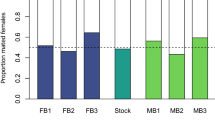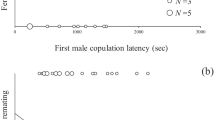Summary
Females of the field cricket, Gryllus bimaculatus, are known to mate non-randomly with respect to male size. The reproductive output of females allowed to choose their mates was compared with that of females allocated mates. Females allowed to choose their mates laid a greater proportion of their available eggs, thereby investing more heavily in reproduction. Female choice did not appear to influence hatching success, suggesting that no short term benefits are derived from non-random mating. However, the offspring of females allowed to choose their mates developed more rapidly and began their own reproductive output before those of females who had been allocated mates. Furthermore, the faster developing offspring of females who chose their mates tended to have a consistantly higher survival rate as well as a lower variance in survival (i.e. less risk of mortality) at adult eclosion. Female choice may therefore contribute to offspring fitness and thus to long term reproductive success. Females allocated large males as mates did not equal those of females allowed to choose their mates, in terms of reproductive output and offspring fitness. This suggests that females may choose their mates with regard to a mixture of characters of which male size is only one.
Similar content being viewed by others
References
Andersson M (1982) Female choice selects for extreme tail length in a widowbird. Nature 299:818–820
Arnold SJ (1983) Sexual selection: the interface of theory and empiricism. In: Bateson P (ed) Mate choice. Cambridge University Press, Cambridge, pp 67–107
Bakker K (1961) An analysis of factors which determine success in competition for food among larvae of Drosophila melanogaster. Arch Neerl Zool 14:200–281
Bakker K (1969) Selection for rate of growth and its influence on competition ability of larvae of Drosophila melanogaster. Neth J Zool 19:541–595
Begon M (1984) Density and individual fitness: asymmetric competition. In: Shorrocks B (ed) Evolutionary ecology. Blackwell, Oxford, pp 175–194
Bentur JS, Dakshayoni K, Mathud SB (1977) Mating induced oviposition and egg production in the crickets Gryllus bimaculatus de Geer and Plebiogryllus guttiventris Walker. Z Angew Entomol 84:129–135
Breed MD, Smith SK, Gall BG (1980) Systems of mate selection in a cockroach species with male dominance hierarchies. Anim Behav 28:130–134
Burley N (1981) Mate choice by multiple criteria in a monogomous species. Am Nat 117:515–526
Charlesworth B (1984) The evolutionary genetics of life history. In: Shorrocks B (ed) Evolutionary ecology. Blackwell, Oxford, pp 117–133
Cole LC (1954) The population consequences of life history phenomena. Quart Rev Biol 29:103–137
Collins NC (1980) Developmental responses to food limitation as indicators of environmental conditions for Ephydra cinerea Jones. Ecology 61:650–661
Cox CR, Le Boeuf BJ (1977) Female incitation of male competition: a mechanism in sexual selection. Am Nat 111:317–335
Darwin CD (1871) The descent of man and selection in relation to sex. Murray, London
Dingle H, Brown CK, Hegmann JP (1977) The nature of genetic variance influencing photoperiodic diapause in a migrant insect, Oncopeltus fasciatus. Am Nat 111:1047–1059
Engelmann F (1970) The physiology of insect reproduction. Pergamon Press, Oxford
Falconer DS (1981) Introduction to quantitative genetics, 2nd ed. Longman, London
Fisher RA (1930) The genetic theory of natural selection, 2nd ed. Oxford University Press, Oxford
Gillespie JH (1977) Natural selection for variance in offspring numbers: a new evolutionary principle. Am Nat 111:1010–1014
Halliday TR (1983) The study of mate choice. In: Bateson P (ed) Mate choice. Cambridge University Press, Cambridge, pp 3–32
Harvey IF, Corbet PS (1985) Territorial behaviour of larvae enhances mating success of male dragonflies. Anim Behav 33:561–565
Hughes AL, Hughes MK (1985) Female choice of males in a polygynous insect, the whitespotted sawyer, Monochomus scutellatus. Behav Ecol Sociobiol 17:385–388
Istock CA (1978) Fitness variation in a natural population. In: Dingle H (ed) Evolution of insect migration and diapause. Springer, Berlin Heidelberg New York, pp 171–190
Istock CA (1983) The extent and consequences of heritable variation for fitness characters. In: King CE, Dawson PS (eds) Population biology: retrospect and prospect. Columbia University Press, Columbia, pp 61–96
Kodric-Brown A (1983) Determinants of male reproductive success in pupfish (Cyprinoden pecesensis). Anim Behav 31:128–137
Lande R (1976) The maintenance of genetic variability by mutation in a polygenic character with linked loci. Genet Res 26:221–235
Lande R (1981) Models of specification by sexual selection of polygenic traits. Proc Natl Acad Sci USA 78:3721–3725
Lewontin RC (1965) Selection for colonizing ability. In: Baker HG, Stebbins GL (eds) The genetics of colonizing species. Academic Press, New York, pp 77–94
Loher W, Rence B (1978) The mating behaviour of Teleogryllus commodus (Walker) and its central and peripheral control. Z Tierpsychol 46:225–259
Maynard Smith J (1956) Fertility, mating behaviour and sexual selection in Drosophila subobscura. J Genet 54:261–279
Maynard Smith J (1978) The evolution of sex. Cambridge University Press, Cambridge
Meats A (1971) The relative importance to population increase of fluctuations in mortality, fecundity and the time variable of the reproductive schedule. Oecologia (Berl) 6:223–237
Merkel G (1977) The effects of temperature and food quality on the larval development of Gryllus bimaculatus (Orthoptera, Gryllidae). Oecologia (Berl) 30:129–140
Moeur JE, Istock CA (1980) Ecology and evolution of the pitcher-plant mosquito. IV. Larval influence over adult reproductive performance and longevity. J Anim Ecol 49:775–792
O'Donald P (1980) Sexual selection by female choice in a monogamous bird: Darwins theory corroborated. Heredity 45:201–217
O'Donald P (1983) Sexual selection by female choice. In: Bateson P (ed) Mate choice. Cambridge University Press, Cambridge, pp 53–66
Parker GA (1982) Phenotype-limited evolutionary stable strategies. In: Bertram BR, Clutton-Brock TH, Dunbar RIM, Rubenstein DI, Wrangham R (eds) Current problems in sociobiology. Cambridge University Press, Cambridge, pp 173–201
Parker GA (1983) Mate quality and mating decisions. In: Bateson P (ed) Mate choice. Cambridge University Press, Cambridge, pp 141–166
Partridge L (1980) Mate choice increases a component of offspring fitness in fruit flies. Nature 283:290–291
Partridge L (1983) Non-random mating and offspring fitness. In: Bateson P (ed) Mate choice. Cambridge University Press, Cambridge, pp 227–255
Partridge L, Halliday TR (1984) Mating patterns and mate choice. In: Krebs JR, Davies NB (eds) Behavioural ecology: an evolutionary approach. Blackwell, London, pp 222–250
Prout T, McChesney F (1985) Competition among immatures affects their adult fertility: population dynamics. Am Nat 126:521–558
Qayyum HA, Wahla MM (1969) Biology of Gryllus bimaculatus De Geer. Pakist J Sci Res 21:112–116
Ryan MJ (1980) Female mate choice in a neotropical frog. Science 209:523–525
Rivnay E, Ziv M (1963) Contribution to the biology of Gryllus bimaculatus Deg, in Israel. Bull Ent Res 54:37–43
Sang JH, Clayton GA (1957) Selection for larval development time in Drosophila. J Heredity 48:265–270
Sigurjonsdottir H (1984) Food competition among Scatophaga stercoraria larvae with emphasis on its effects on reproductive success. Ecol Entomol 9:81–90
Simmons LW (1986a) Intermale competition and mating success in the field cricket, Gryllus bimaculatus (De Geer). Anim Behav 34:567–579
Simmons LW (1986b) Female choice in the field cricket, Gryllus bimaculatus (De Geer). Anim Behav 34:1463–1470
Simmons LW (1987a) Competition between larvae of the field cricket, Gryllus bimaculatus (Orthoptera: Gryllidae) and its effects on some life history components of fitness. J Anim Ecol (in press)
Simmons LW (1987b) Male size, mating potential and lifetime reproductive success in the field cricket, Gryllus bimaculatus (De Geer). Anim Behav (in press)
Simmons LW (1987c) Heritability of a male character chosen by females of the field cricket, Gryllus bimaculatus. Behav Ecol Sociobiol 21:129–133
Simmons LW (1987d) Sperm competition as a mechanism of female choice in the field cricket, Gryllus bimaculatus. Behav Ecol Sociobiol 21:197–202
Thornhill R (1980) Competitive charming males and choosy females: was Darwin correct? Fla Entomol 63:5–30
Thornhill R (1983) Cryptic female choice and its implications in the scorpion fly Horpobittacus nigriceps. Am Nat 122:765–788
Van Noordwijk AJ, Van Balan JH, Scharloo W (1980) Heritability of ecologically important traits in the great tit (Parus major L.). Ardea 68:193–203
Williams GC (1975) Sex and evolution. Princeton University Press, Princeton USA
Williams SM (1985) The maintenance of polymorphism owing to differences in development time and competition. Can J Genet Cytol 27:328–333
Author information
Authors and Affiliations
Rights and permissions
About this article
Cite this article
Simmons, L.W. Female choice contributes to offspring fitness in the field cricket, Gryllus bimaculatus (De Geer). Behav Ecol Sociobiol 21, 313–321 (1987). https://doi.org/10.1007/BF00299969
Received:
Accepted:
Issue Date:
DOI: https://doi.org/10.1007/BF00299969




